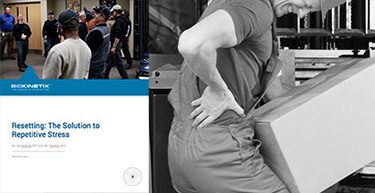Resetting: The Solution to Repetitive Stress Syndrome
At BIOKINETIX, we offer actionable tools that employers can use to empower their employees to live more active, productive lives, both in the workplace and in how they approach exercise outside of the workplace as a result. One way we do this is by ongoing education at work-sites, as well as offering white papers that explore our science-backed methodologies and the research behind them.
This whitepaper explores repetitive stress syndrome and how “resetting” can help address habitual movement patterns that cause it. Download our white paper for free to learn more, and enjoy our abstract, frequently asked questions, and sample below.
Abstract:
Repetitive stress syndrome remains one of the most consequential health risks facing today’s workforce, from industrial workers to musicians. Performing the repetitive movements demanded by certain job tasks affects not only musculoskeletal function, but also the circulatory, lymphatic, and nervous systems. One of the best ways to prevent repetitive stress injury starts with the concept of reciprocal inhibition: when a muscle is contracted, the muscles on the other side of the joint relax automatically. Resetting, or strengthening the muscle groups opposite the ones being repetitively used, is an effective way to protect the body from repetitive stress.
How does repetitive stress syndrome impact the body?
Repetitive stress has been proven to adversely affect the health and function of various bodily systems in several ways. This not only impacts not only the overall performance of each employee, but impacts their overall health and wellness. Some of the body systems impacted include tight muscles, poor posture, inflamed tendons, and nerve impingement, just to name a few.
What happens to the body after repetitive stress syndrome treatment?
Resetting muscles allows the body to reduce damage from repetitive movements. Amongst other things, it does so by lengthening repetitively used muscles, effectively alleviating tightness.
White Paper Sample:
Musculoskeletal disorders and repetitive stress injuries (RSIs) are one of the leading causes of occupational injury in U.S. businesses, along with hundreds of thousands of days away from work per year [1]. In the past several decades, there has been a significant increase—not only in the U.S., but worldwide—of reported RSIs in the neck, shoulders, arms, and hands, a phenomenon which dates back to the growing use of computers, CNC machinery, and related technology in the home and workplace that require the user to engage in repetitive motions [9].
RSIs are characterized by overuse of the tendons and muscles through repetitive motion. This is mainly due to the repetitive movements that are demanded of people in order to perform certain physical tasks, which are often accompanied by poor posture; for example, sitting at a computer or using mass production machines not only involves the repetitive movements of the hand and arm required to type and navigate, but also remaining in a fixed (and most likely a non-neutral) posture while doing so. Repetitive stress subjects the body to a variety of adverse effects, some of which include the shortening or tightness of muscles, the inflammation of tendons, the impingement of nerves, and the inhibition in the circulation of the blood and lymphatic fluids.
Additionally, RSIs have the potential to negatively impact quality-of-life; from carpal tunnel syndrome to back pain and rotator cuff injuries, repetitive stress poses a very real obstacle to performing physically-intensive job tasks and even the ability to complete daily activities if left unchecked. When a worker’s ability to perform these tasks is diminished as a result of an RSI, it means more downtime, both inside and out of the workplace. In order to combat the effects of repetitive stress and to help prevent RSIs, repetitively used muscles must be “reset” …
Discover all of the benefits by downloading the white paper now.




